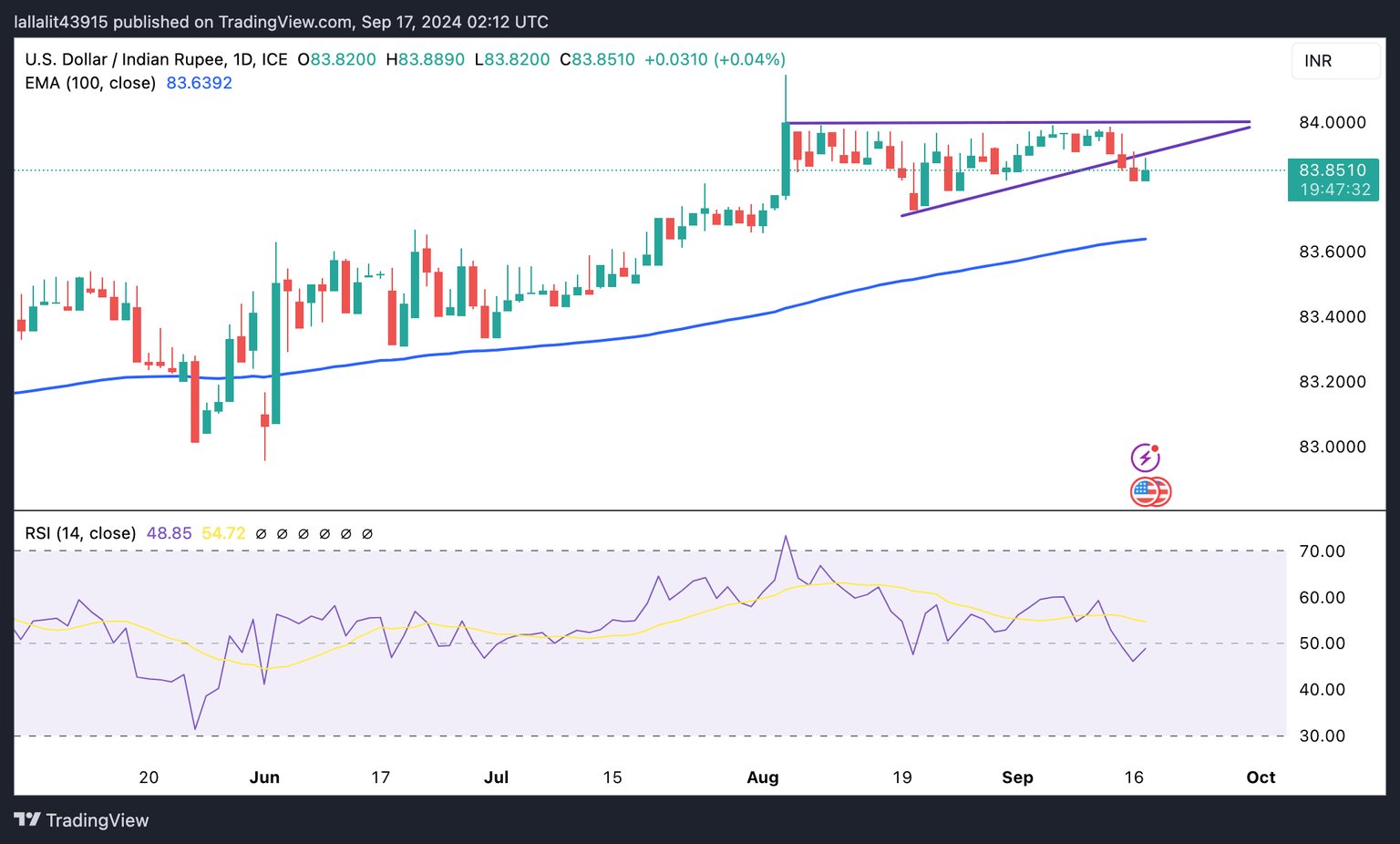USD/INR posts modest gains, Indian WPI Inflation eases to 1.31% in August
- Indian Rupee (INR) loses ground in Tuesday’s early European session.
- India’s Wholesale Price Index (WPI) Inflation eased to 1.31% YoY in August from 2.04% in July, weaker than the 1.80% expected.
- Renewed USD demand, higher oil prices undermine the INR; growing expectation of deeper Fed rate cut might cap its downside.
- The US Retail Sales data will be the highlight later on Tuesday.

The Indian Rupee (INR) edges lower on Tuesday, snapping the three-day winning streak. India's Wholesale Price Index (WPI)-based inflation declined to 1.31% YoY in August from 2.04% in the previous reading. This figure came in below the market consensus of 1.80%, according to the latest official data released on Tuesday. The INR trades with mild losses in response to the cooler Indian inflation report.
Meanwhile, the robust US Dollar (USD) demand from local importers, particularly oil companies, weighs on the local currency. Additionally, the rebound in crude oil prices could limit the INR’s upside as India is the third-largest oil consumer after the United States (US) and China.
Nonetheless, the firmer bets on the jumbo Federal Reserve (Fed) rate cut, weaker Greenback and significant foreign fund inflows into Indian equities might support the appreciation of the INR. Looking ahead, investors will keep an eye on US Retail Sales on Tuesday. The figure is expected to rise 0.2% MoM in August versus a 1.0% rise in July.
Daily Digest Market Movers: Indian Rupee seems vulnerable as traders await the key events
- "Positive rate of inflation in August, 2024 is primarily due to increase in prices of food articles, processed food products, other manufacturing, manufacture of textiles and manufacture of machinery & equipment etc.," the government said.
- India's economy is estimated to grow at a rate of around 7.5% or more, according to Reserve Bank of India (RBI) Governor Shaktikanta Das. This projection surpasses the RBI's current forecast of 7.2% for the ongoing financial year.
- The US NY Empire State Manufacturing Index improved to 11.5 in September from a decline of 4.7 in August, better than the estimation of a 3.9% decrease.
- Fed fund futures show investors are increasingly betting the US Fed will cut by 50 basis points (bps) instead of 25 bps. Traders are now pricing in a nearly 67% chance of a reduction of 50 bps, up from 50% on Friday, according to the CME FedWatch Tool.
- "We had favoured a 50bp cut, but the latest job and inflation numbers suggest officials will more likely vote in favour of 25bps”, said ING Bank analysts.
Technical Analysis: USD/INR still maintains constructive outlook
A decisive break above the 83.90-84.00 region, support-turned resistance level and psychological mark, could spur another bounce back to the immediate upside barrier around 84.50.
On the downside, the low of September 16 at 83.82 acts as an initial support level for USD/INR. Any follow-through selling below this level will expose the 100-day EMA at 83.64.

Inflation FAQs
Inflation measures the rise in the price of a representative basket of goods and services. Headline inflation is usually expressed as a percentage change on a month-on-month (MoM) and year-on-year (YoY) basis. Core inflation excludes more volatile elements such as food and fuel which can fluctuate because of geopolitical and seasonal factors. Core inflation is the figure economists focus on and is the level targeted by central banks, which are mandated to keep inflation at a manageable level, usually around 2%.
The Consumer Price Index (CPI) measures the change in prices of a basket of goods and services over a period of time. It is usually expressed as a percentage change on a month-on-month (MoM) and year-on-year (YoY) basis. Core CPI is the figure targeted by central banks as it excludes volatile food and fuel inputs. When Core CPI rises above 2% it usually results in higher interest rates and vice versa when it falls below 2%. Since higher interest rates are positive for a currency, higher inflation usually results in a stronger currency. The opposite is true when inflation falls.
Although it may seem counter-intuitive, high inflation in a country pushes up the value of its currency and vice versa for lower inflation. This is because the central bank will normally raise interest rates to combat the higher inflation, which attract more global capital inflows from investors looking for a lucrative place to park their money.
Formerly, Gold was the asset investors turned to in times of high inflation because it preserved its value, and whilst investors will often still buy Gold for its safe-haven properties in times of extreme market turmoil, this is not the case most of the time. This is because when inflation is high, central banks will put up interest rates to combat it. Higher interest rates are negative for Gold because they increase the opportunity-cost of holding Gold vis-a-vis an interest-bearing asset or placing the money in a cash deposit account. On the flipside, lower inflation tends to be positive for Gold as it brings interest rates down, making the bright metal a more viable investment alternative.
Author

Lallalit Srijandorn
FXStreet
Lallalit Srijandorn is a Parisian at heart. She has lived in France since 2019 and now becomes a digital entrepreneur based in Paris and Bangkok.

















